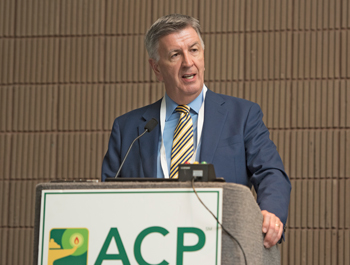Two key questions guide H. pylori treatment
The best and most cost-effective treatments for H. pylori infection are the ones that work.
As one of the most common chronic bacterial infections, Helicobacter pylori is a known enemy due to its potential to cause peptic ulcer disease and gastric cancer. But in today's era of antibiotic resistance, the infection now requires more ammunition to be defeated.
For many years, standard treatment for H. pylori was clarithromycin triple therapy, a combination of clarithromycin, amoxicillin or metronidazole, and a proton-pump inhibitor (PPI) for 14 days. But the three-part regimen has fallen out of favor, said gastroenterologist Colin W. Howden, MD, during his session on common upper GI problems at Internal Medicine Meeting 2018.

“In large parts of the country, I would say that this should no longer be recommended and this treatment is largely obsolete,” he said.
So what are the best and most cost-effective treatments for H. pylori infection? Simply put, the ones that work, said Dr. Howden, professor of medicine at the University of Tennessee Health Science Center in Memphis.
“Irrespective of dollars and cents, the most expensive treatment is the one that doesn't work,” he said. “And there are a heck of a lot of treatments out there for H. pylori that don't work.”
New treatment guideline
While testing for antimicrobial sensitivity often guides treatment for other bacterial infections, it is not routinely available for H. pylori, Dr. Howden noted. “It's expensive, it's difficult to obtain, and many of us do not have access to it, so therefore, the treatment of H. pylori infection is largely empiric.”
Recent guidance provides some new direction. In 2017, the American College of Gastroenterology published an updated clinical guideline for the treatment of H. pylori infection. Dr. Howden, a coauthor of the guideline, outlined the two treatment regimens that internists should focus on when managing most of their patients.
The first, bismuth-based quadruple therapy, includes bismuth, tetracycline, metronidazole, and a PPI for 10 to 14 days, but preferably 14 days, he said. “Bismuth-based quadruple therapy was one of the initial treatments for H. pylori and now is back in fashion again.”
The second regimen, called concomitant therapy, involves clarithromycin, amoxicillin, metronidazole, and a PPI for 10 to 14 days (again, preferably 14 days). “It's kind of a kitchen-sink approach. Throw everything at the bug,” Dr. Howden said. “In essence, concomitant therapy is clarithromycin triple therapy with the addition of metronidazole.”
Because treatment is largely empiric, “We have to be careful when we choose a particular treatment regimen for a specific patient,” he cautioned.
Dr. Howden said there are two key questions to consider when choosing a regimen for an individual patient:
- 1. Has there been previous exposure to macrolide antibiotics (e.g., clarithromycin, azithromycin, erythromycin) for any reason, and
- 2. Is the patient allergic to penicillin?
An additional consideration is the local antibiotic resistance pattern, although this information isn't always available, he noted.
“If the patient has been exposed to macrolides for any reason, then you should probably be avoiding clarithromycin as a treatment for H. pylori,” Dr. Howden said. Why? Because the bug likely remembers how to withstand it, he said, noting that virtually all adults with H. pylori caught the infection in childhood.
“That bug has been living in their stomach for most of their lives,” Dr. Howden said. “Every tablet of antibiotic that that patient has ever swallowed has been sensed by the H. pylori, and if the patient has received a macrolide before, for a respiratory infection for example, you should assume that the bug is resistant to clarithromycin.”
As for penicillin allergy, expect this to be a rarity. “Up to 10% of the adult U.S. population claims to be allergic to penicillin, and it's simply not true. Of these, about 90% have negative skin testing indicating no true allergy,” he noted, emphasizing that unnecessary avoidance of penicillin is a public health concern because it leads to the overuse of non-beta-lactam antibiotics.
This is important when treating H. pylori infection because amoxicillin remains a crucial medicine, Dr. Howden said. “H. pylori hardly ever becomes resistant to amoxicillin. It just needs to sniff clarithromycin and it's resistant to it, but for reasons that are unclear, at least to me, amoxicillin resistance among H. pylori is exceedingly rare,” he said.
If there is no history of macrolide use or penicillin allergy, bismuth quadruple therapy and concomitant therapy are both good choices, Dr. Howden said, adding that clarithromycin triple therapy is also OK to use if the local resistance rate to clarithromycin in H. pylori strains is under 15%. “I would wager that most of the United States would not fulfill that criterion,” he said.
If there's no penicillin allergy but the patient has previously received a macrolide, then bismuth quadruple therapy would be ideal, Dr. Howden said. If the patient is allergic to penicillin but has never received macrolides, bismuth quadruple therapy is still a good option, although clarithromycin triple therapy can be also be used if amoxicillin is replaced with metronidazole, he said. For those who are both allergic to penicillin and previous macrolide users, bismuth quadruple therapy is essentially the only option, Dr. Howden said.
“I tell the GI fellows where I work [that] bismuth quadruple therapy is never the wrong answer” when treating H. pylori infection, he said.
After treatment
Despite the effectiveness of a 14-day course of four different medicines, the regimen is complicated for patients to take. Dr. Howden advises discussing both the rationale of the regimen and any adverse events that may be expected.
First, it's important that patients adhere to the full regimen. Failure to take at least 80% of the prescribed medicine is strongly predictive of failure of eradication, and failure of eradication often leads to antibiotic-resistant strains of the bacteria, he said.
“I'd rather you ignored the H. pylori infection and didn't treat it than treat it inadequately or give an ineffective regimen because that's just encouraging the emergence of resistant strains,” Dr. Howden said.
As for adverse events, diarrhea is very common with these combinations of antibiotics, he noted, and clarithromycin and metronidazole can also cause taste disturbance. In addition, there is an alcohol interaction with metronidazole. “It's not serious, but it's not particularly pleasant, so patients should be advised to avoid alcohol when they're taking metronidazole,” Dr. Howden said.
While diagnosis and treatment of H. pylori are important because the infection can be associated with serious long-term outcomes, “There's an equally good case for making sure that the infection has been successfully cured because reinfection rates are very, very low, less than 1% within a year,” he said. “Once this infection's cured, it tends to stay cured.”
In addition, overall eradication rates are only 70% to 80% (even with complete adherence), and symptoms like dyspepsia do not indicate success or failure of eradication, Dr. Howden said. “We feel that there's a strong case for routine post-treatment testing.”
Therefore, management of H. pylori infection involves testing, treating, then retesting. Dr. Howden emphasized that post-treatment testing must be performed with a test for active H. pylori infection, such as a urea breath test, a fecal antigen test, or a biopsy-based test if the patient is having endoscopy performed. Serology after treatment is a big no-no.
“I tell my patients, ‘If anyone offers a blood test for H. pylori, be polite, remember Nancy Reagan, just say no.’ … You can cure H. pylori infection and serology will stay positive for years, if not indefinitely,” he said. “I have seen patients with cured H. pylori infection who have been sent back to me because of a positive blood test.”
Testing to prove eradication must be done no sooner than four weeks after the end of treatment, and the patient should not have taken PPIs, antibiotics, or bismuth for two weeks prior to the test, Dr. Howden said.
The two big predictors of failure of eradication are poor adherence to treatment regimens and antibiotic resistance (particularly with clarithromycin), he said.
“Retreatment with the initial failed regimen is something I see repeatedly in clinical practice, especially with clarithromycin,” Dr. Howden said. “If clarithromycin-based therapy fails once, it's going to fail again. So just don't do it.” Bismuth quadruple therapy is especially appropriate when patients do not respond to a clarithromycin-containing regimen, he added.
In general, avoid reusing the same antibiotics again when first-line therapy fails, Dr. Howden said. “The two exceptions are amoxicillin and tetracycline. … Resistance to those antibiotics is, for all intents and purposes, zero.”
And when treatment fails, “I think you should feel free to consult with your gastroenterologist, and salvage regimens need to be selected carefully,” he said. “The American College of Gastroenterology guideline gives some advice about that.”
If treatment fails three times or more, Dr. Howden said it may be time to give up—for now. He suggested treating dyspeptic symptoms to the best of your ability and reassuring patients that better regimens may become available to treat the infection.
“When all else fails, as it will in the treatment of H. pylori infection, I remind patients that there are worse things to live with than H. pylori,” he said.



